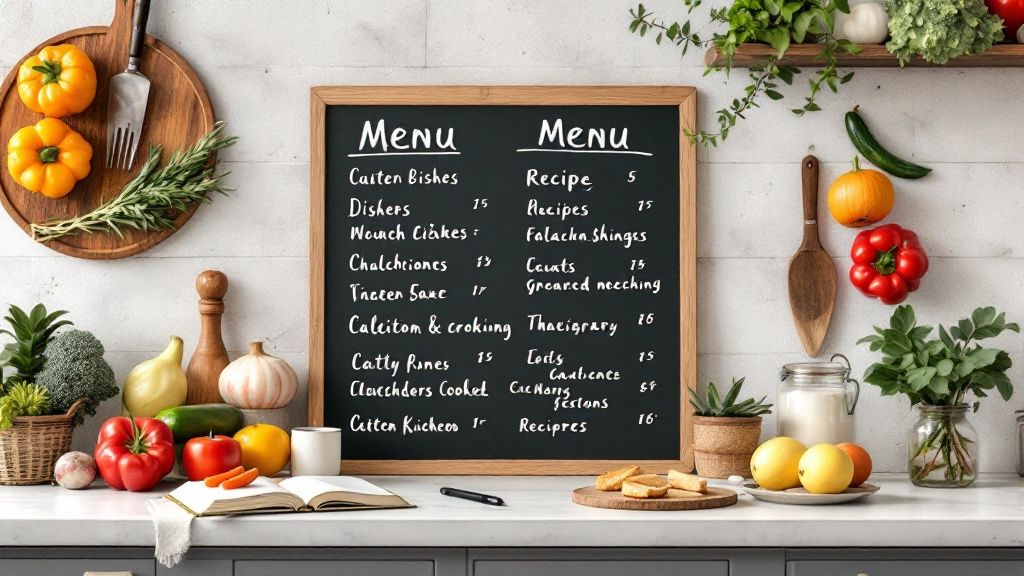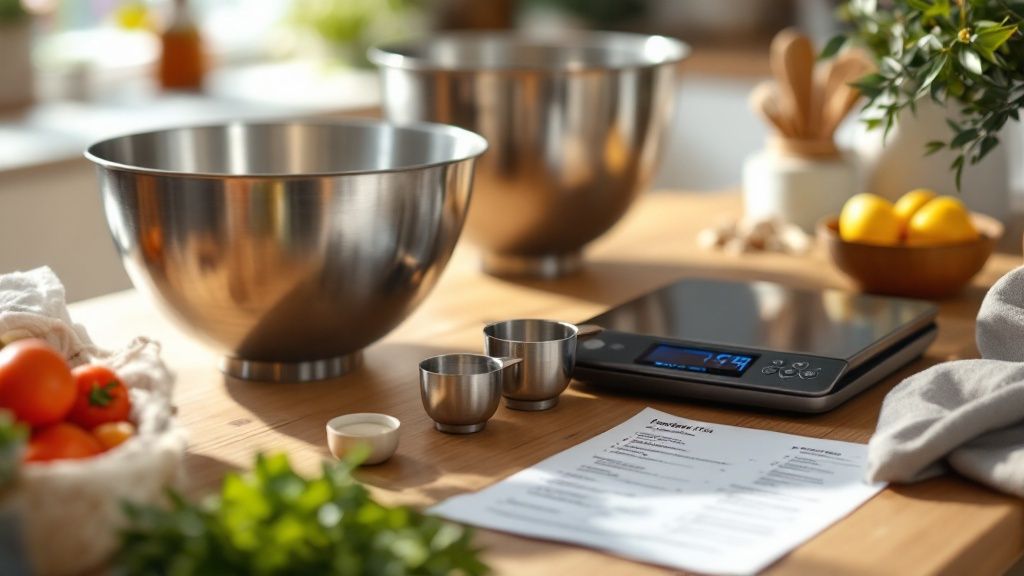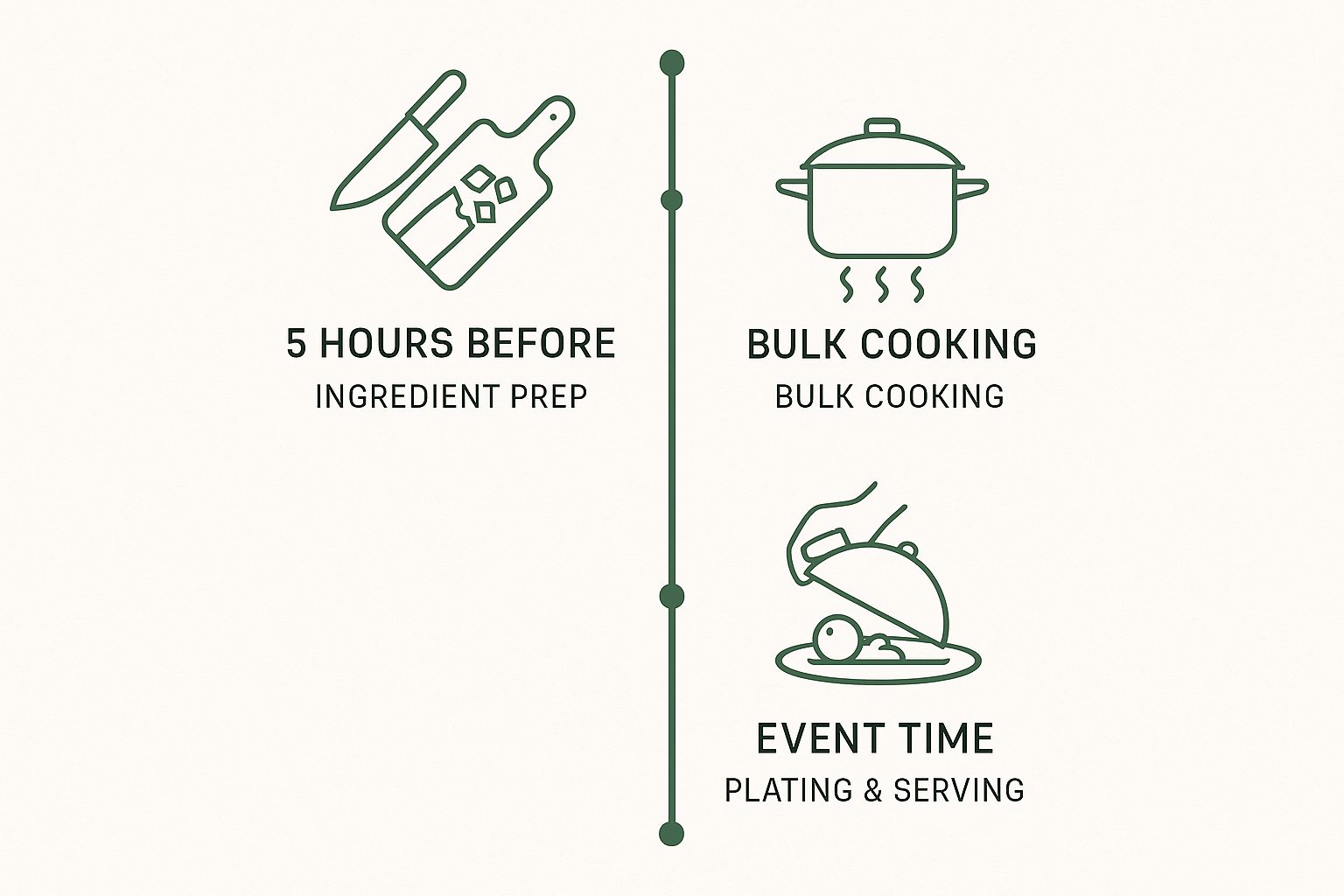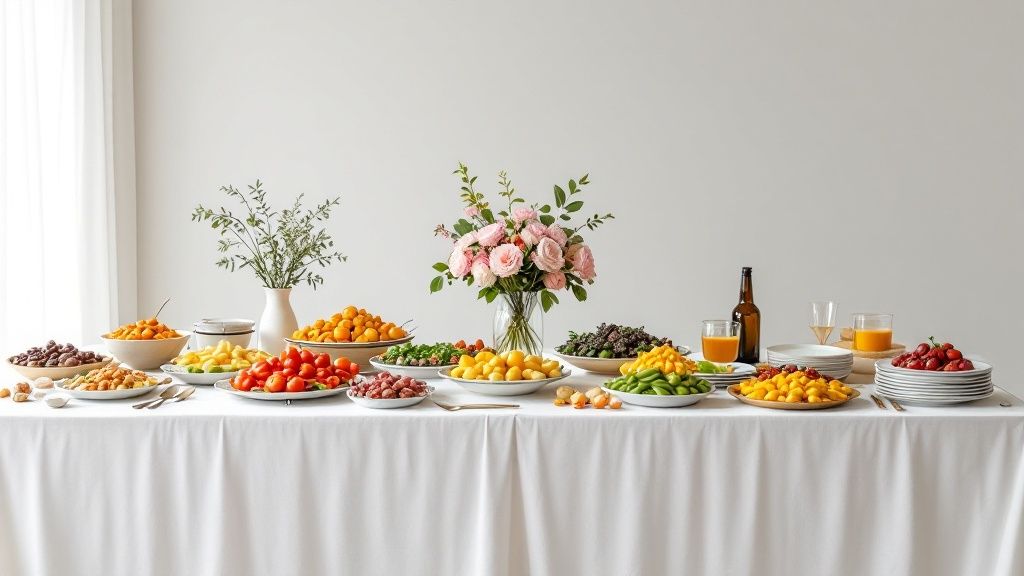Cooking for Large Groups Without the Stress
Cooking for large groups can feel like taming a wild beast—or a thrilling project, depending on your approach. Shift your perspective from simply feeding a crowd to staging a memorable event, and you’ll find it’s all about smart menu choices, a realistic preparation schedule, and an organized kitchen.
The Blueprint For Calm And Confident Crowd Cooking

Forget the last-minute frenzy. The real line between chaos and composure isn’t a culinary degree—it’s a robust plan. Treat this as a fun backyard project, and you might actually have time to chat with guests.
Meanwhile, professional caterers have this dialed in. The global catering management market hit USD 118.3 billion in 2025, and it’s climbing. If you want the full lowdown on industry standards, check out Future Market Insights.
Your Group Cooking Success Blueprint
Here’s an at-a-glance view of the pillars that will transform your kitchen into a well-oiled machine.
| Pillar | Core Focus | Key Outcome |
|---|---|---|
| Menu Strategy | Selecting scalable dishes that hold up over time | Minimal day-of prep with maximum flavor |
| Master Prep Plan | Spreading tasks across multiple days | Smooth timeline and stress-free execution |
| Kitchen Logistics | Designing an efficient workspace and tool layout | Bottleneck-free workflow |
| Flawless Execution | Orchestrating final steps with precision timing | Hot, beautifully plated dishes served on cue |
Keep this blueprint close as you move from planning to plating. With these pillars in mind, you’re ready to turn a daunting to-do list into a seamless culinary experience—and actually enjoy the party you’ve hosted.
Building a Menu That Works for Everyone

When you’re cooking for a crowd, your menu is your single most important tool. This isn’t the time to pull out your most impressive, complicated recipes. It’s all about strategy. Your goal is to choose dishes that not only taste fantastic but also make your life easier on the day of the event.
Think about what scales up without falling apart. A delicate, pan-seared fish for 30 people? That’s a logistical nightmare waiting to happen. But a huge batch of pulled pork that simmers away for hours, getting better with every minute? That’s your ticket to success. The best menus for large groups are built on recipes that are forgiving, can be made in stages, and hold up beautifully at room temperature.
Choose Scalable and Make-Ahead Friendly Dishes
Let me tell you, dishes you can prep—or even fully cook—in advance are your new best friends. This is the absolute key to keeping your stress levels down when you’ve got a house full of hungry people.
- Buffet-Style Bars: I love setting up taco bars, baked potato stations, or even a build-your-own pasta bar. They’re interactive, everyone gets exactly what they want, and you can prep every single component separately ahead of time.
- Braised and Slow-Cooked Meats: Pulled pork, beef brisket, and carnitas are superstars for a reason. They get more tender the longer they cook and can be kept warm for hours without any drop in quality.
- Hearty Casseroles: You can’t go wrong with a classic baked ziti or a comforting chicken and rice casserole. Assemble it the day before, stash it in the fridge, and just pop it in the oven before it’s time to eat.
To really make your flavors pop, fresh herbs are a must. Having a small indoor garden with the easiest herbs to grow indoors means you’ll always have a fresh supply of aromatics, even when you’re cooking for an army.
Key Takeaway: The perfect menu for a crowd is 80% complete before the first guest even walks through the door. That last hour should be for simple assembly, reheating, and adding garnishes—not frantic, last-minute cooking.
This isn’t just a home-cooking trick; it’s standard practice in the professional world. There’s a reason corporate catering is such a massive industry. In fact, a recent survey found that 53% of corporate food buyers plan to increase their catering budgets, which just goes to show how critical well-planned group meals are.
Accommodating Dietary Needs Without Doubling Your Work
Handling dietary restrictions doesn’t have to mean cooking five different meals. The secret is to build flexibility right into your menu from the start. “Build-your-own” concepts are brilliant for this.
Take that taco bar, for example. You can offer both corn tortillas (gluten-free) and flour tortillas. For fillings, have seasoned ground beef, shredded chicken, and a fantastic black bean and roasted veggie mix (perfect for vegetarians and vegans). Then, lay out all the toppings—salsa, guacamole, cheese, sour cream, shredded lettuce—and let everyone build their perfect plate.
This approach puts your guests in control and shows you respect their needs, all without creating a ton of extra work for you. If you’re looking for more ideas, we’ve got a whole guide on the best party food ideas that are designed to please just about everyone: https://theculinarycollectiveatl.com/best-party-food-ideas/
With just a few smart adjustments, you can make sure everyone feels included and walks away happy and well-fed.
Creating Your Master Prep Timeline
A relaxed host is a well-prepared host. The secret to that calm? A rock-solid timeline. If you want to pull off a big meal without losing your mind, you need to stop thinking in hours and start thinking in days.
The trick is to work backward from the moment you plan to serve the food. By mapping out every single task, you can turn a monumental job into a series of small, manageable steps. This project-management mindset spreads the workload out, preventing that last-minute kitchen chaos we all dread. It’s exactly how professionals handle massive events with grace, and you can absolutely use the same strategy at home.
This timeline gives you a visual breakdown of those critical final hours, showing how the focus shifts from chopping and mixing to simply heating and assembling.

As you can see, the hours right before the party are for finishing touches, not starting from scratch.
Working Backwards From Event Day
Start with your “serve time” and work your way back, first in hours, then in days. You’ll be amazed at how many tasks can be checked off your list long before the first guest even thinks about heading your way.
Pro Tip: Your freezer is your best friend. So many dishes—casseroles, sauces, soups, and even some baked goods—can be made weeks ahead and frozen. This is a game-changer for reducing your day-of workload.
For example, a big, bubbly pan of mac and cheese is always a crowd-pleaser, but it’s a pain to make on party day. Good news: our guide explains exactly how you can freeze baked macaroni and cheese, turning a time-consuming classic into a simple heat-and-serve dish.
Sample Timeline Breakdown
Let’s walk through a practical example of how this works. Imagine you’re throwing a party on a Saturday evening. Here’s a simple prep schedule to keep things smooth and stress-free.
This sample timeline shows how you can break down the prep for a weekend party over three days.
| Day | Tasks to Complete | Goal for the Day |
|---|---|---|
| 3 Days Out (Wednesday) | Finalize menu. Create master grocery list. Check pantry staples. Make & freeze any sauces. | Have a complete plan and shopping list ready to go. |
| 2 Days Out (Thursday) | Go grocery shopping. Chop sturdy veggies (onions, carrots, peppers). Store in airtight containers. | Get all ingredients in-house and do some initial knife work. |
| 1 Day Out (Friday) | This is your main prep day. Assemble casseroles, marinate meats, mix dressings, bake desserts. | Get 80% of the food prep done. Set the table and lay out serving dishes. |
| Day Of (Saturday) | Cook proteins. Reheat pre-made dishes. Toss salads. Arrange everything for serving. | Focus on final execution, not prep. Enjoy your party! |
By front-loading the work, you save yourself from a world of stress on the day of the event.
This phased approach prevents kitchen gridlock and mental burnout. It’s the same principle the professional catering industry runs on—a sector projected to grow from $164.59 billion to an incredible $292.56 billion by 2034. That growth is all about managing an increasing number of events with efficiency. By adopting a similar timeline-focused strategy, you bring that professional calm into your own kitchen.
Setting Up Your Kitchen for Success

Let’s be honest: your home kitchen wasn’t designed to be a high-volume restaurant. But that doesn’t mean it can’t be. The real secret to a smooth, stress-free cooking day is turning your space into an efficient command center. This isn’t about having a massive, commercial-grade kitchen; it’s about smart organization and creating a workflow that makes sense. A little forethought now prevents that frantic moment of searching for a whisk while your sauce is burning.
First things first, do a quick but honest equipment audit. Walk through your menu and make a list of every single tool you’ll need. Do you have enough big sheet pans for roasting all those vegetables, or will you be stuck doing it in four tiny batches? Is your largest stockpot truly big enough for a chili meant to feed 30 people?
Facing your kitchen’s limitations head-on is a game-changer. It’s far better to realize you need another large mixing bowl now than when you’re halfway through prepping a massive salad.
Creating Efficient Workflow Stations
Professional kitchens run on a system of “stations,” a concept you can easily bring into your home. Designating specific counter areas for different tasks keeps everything organized and, crucially, prevents cross-contamination. This one move can stop your workspace from descending into utter chaos.
- Prep Station: This is your chopping and measuring zone. Keep your cutting boards, knives, and a compost bowl right here. All raw ingredients get processed in this spot.
- Mixing and Assembly Station: Set this area up with your mixing bowls, stand mixer, and measuring cups. This is where you’ll combine ingredients for casseroles, sauces, or dressings.
- Cooking Zone: This is your stovetop and oven area. Make sure your spatulas, tongs, and oven mitts are within easy reach. No running across the kitchen with a hot pan!
Separating tasks like this makes the whole process faster and, more importantly, safer. You won’t accidentally place raw chicken next to the fresh greens you’re about to serve. And if you’re thinking about upgrading your gear for big jobs, a good commercial griddle buyer’s guide can be a fantastic resource for expanding your capabilities.
Key Insight: Think of your kitchen layout like a factory assembly line. Ingredients should move logically from the prep station to the assembly station and finally to the cooking zone, minimizing backtracking and countertop clutter.
Mastering Your Cold and Hot Space
Finally, you need a strategy for your two most precious resources: refrigerator and oven space. A single home oven is the number one bottleneck when cooking for a crowd. Plan your cooking times strategically, prioritizing dishes that can be made ahead and simply reheated just before serving.
And don’t underestimate the power of a humble cooler. A large cooler filled with ice can act as a secondary fridge, perfect for holding drinks, marinating meats, or chilling completed salads. This frees up precious shelf space in your main refrigerator for the most critical items, ensuring everything stays at a safe temperature until it’s time to eat.
Managing the Big Day Like a Pro
The big day is finally here. After all that meticulous planning, list-making, and prepping, this is the moment everything comes together. Your goal now is simple: assemble, serve, and actually enjoy the fruits of your labor. The final hours aren’t about cooking from scratch; they’re all about flawless execution.
If you’ve followed a solid prep timeline, this final push should feel more like conducting an orchestra than fighting a kitchen fire. Your focus shifts to reheating, final assembly, and creating an inviting space for your guests. This is where your careful organization truly pays off, transforming potential chaos into a calm, controlled process.
Your Day-Of Execution Checklist
Think of the last two hours before guests arrive as your “go time.” Having a clear, simple checklist ensures nothing gets missed in the excitement and last-minute conversations.
- Final Food Touches: This is the time for tasks that had to wait until the very end. Go ahead and toss the salads with dressing, slice the bread for the basket, and garnish your finished dishes with fresh herbs.
- Set Up the Serving Area: Get your buffet line arranged before the hot food comes out. Place platters, serving utensils, and labels so you know exactly where everything will go. This prevents a last-minute scramble.
- Temperature Management: This is absolutely critical. Start warming your slow cookers and chafing dishes now. For your cold items, get those ice baths ready to go.
This final phase is all about bringing your carefully planned vision to life.
Keeping Food at the Perfect Temperature
One of the biggest challenges when cooking for a crowd is keeping food at a safe and appetizing temperature. Nobody wants lukewarm chili or a wilted, warm salad. It’s not just about taste; it’s about safety.
For hot dishes, slow cookers set to “warm” are your best friends. Seriously. They maintain a consistent heat without continuing to cook the food into oblivion. Inexpensive chafing dishes with fuel burners are also fantastic for a more professional-looking setup.
For cold foods, the solution is beautifully simple: nest your serving bowls into larger trays filled with ice. A basic ice bath keeps dips, salads, and desserts safely chilled and refreshing for hours.
A food safety rule of thumb you can’t ignore: never leave perishable food in the “danger zone” (40°F – 140°F) for more than two hours. Proper heating and cooling methods are your best defense against sending guests home with an unwanted party favor.
The Art of the Buffet Line
Believe it or not, how you arrange your food really matters. A well-designed buffet line creates a sense of abundance and guides guests smoothly through their choices without causing a traffic jam by the mashed potatoes.
Start the line with plates and cutlery. Next, place the salads and lighter fare. This is followed by the main dishes, and finally, any bread or rolls. This logical flow prevents bottlenecks and helps guests build their plates naturally.
Thinking through the presentation and flow of your buffet versus a plated meal can make a huge difference in the guest experience. To help you decide what’s right for your event, learn more about the pros and cons of buffet or plated service in our detailed guide.
But the most important ingredient for success on the big day? Delegation. When a guest asks, “What can I do to help?” have a small, specific job ready. Ask them to refill the ice bucket, manage the music playlist, or clear empty cups. Accepting help graciously allows you to stay present and makes your guests feel valued. It’s the final step in managing the day like a pro—and actually getting to be a guest at your own party.
Answering Your Big-Batch Cooking Questions
Even the most seasoned host hits a snag or two when cooking for a crowd. Let’s be honest, a few questions always pop up. Knowing how to handle these little challenges is what turns a potentially stressful day into a smooth, successful party.
Think of this as your quick-reference guide for those “oh no, what do I do now?” moments. I’ve been there, and I’ve got the answers to get you through.
How Much Food Do I Actually Need to Make?
Figuring out the right amount of food is probably the biggest source of cooking anxiety. Nobody wants to run out, but you also don’t want to be stuck eating pulled pork for the next two weeks. I stick to a pretty reliable guideline called the “one pound rule.”
The idea is simple: plan for about one pound of total food per adult, not counting drinks or dessert. It’s an easy way to visualize the total volume you’re aiming for.
From there, you can break it down:
- The Main Event (Protein): Aim for 6-8 ounces of protein like chicken, beef, or pork per person. If you’re serving something with a bone in it, like chicken wings or ribs, bump that amount up a bit to account for the bone weight.
- All the Sides: Plan on about 1/2 to 3/4 cup of each side dish for every guest. I always recommend overestimating your sides just a little—people love having a variety to choose from.
Let’s put it into practice: Say you’re having 20 adults over. You’ll need about 20 pounds of food total. That could look like 8-10 pounds of brisket and five different side dishes that add up to another 10-12 pounds.
What Are the Best Kinds of Dishes for a Crowd?
The secret to crowd-pleasing dishes? They need to be forgiving and require almost zero last-minute fuss. Your goal is to serve incredible food without being chained to the stove while everyone else is having fun.
Focus on recipes you can prep—or even fully cook—ahead of time and that hold their temperature well. Think big-batch recipes that get better as they sit.
Some of my go-tos include:
- Hearty casseroles
- Braised meats like beef brisket or pulled pork
- Large salads with sturdy greens (kale, cabbage) that won’t wilt
- Interactive food bars (tacos, baked potatoes, etc.)
Steer clear of anything that needs to be cooked à la minute for each guest, like pan-seared scallops or steaks cooked to order. Save those for a smaller dinner party.
How Do I Keep Everything at a Safe Temperature?
This one is non-negotiable. Food safety is paramount, especially with a large group. The golden rule is simple: keep hot food hot and cold food cold.
For your hot dishes, slow cookers set to “warm” are your best friend. You can also rent or buy a few affordable chafing dishes. These are lifesavers for maintaining a consistent temperature above the 140°F safety zone without turning your food to mush.
For cold items, a simple ice bath does the trick. Just nest your serving bowls inside a larger pan or tray filled with ice. This will keep everything safely chilled below 40°F. And don’t forget the two-hour rule—perishable food shouldn’t sit at room temperature for more than two hours.
What’s the Easiest Way to Handle Drinks?
A self-serve drink station. Seriously, it will save your sanity. Set it up in a spot away from the main food line to avoid a traffic jam in your kitchen.
Grab a couple of large beverage dispensers for big batches of iced tea, lemonade, or infused water. If you’re serving booze, mixing up a signature cocktail in a large pitcher is a thousand times easier than playing bartender all night.
Make sure the station is fully stocked with plenty of ice, cups, a bottle opener, and a clearly marked bin for recycling. The more self-sufficient it is, the more you get to enjoy your own party.
Planning a meal for a crowd is a big undertaking, but you don’t have to tackle it alone. If you’d rather enjoy your event without the stress, Culinary Collective Atl offers expert private chef services to create an unforgettable dining experience for you and your guests. Discover how we can help.





